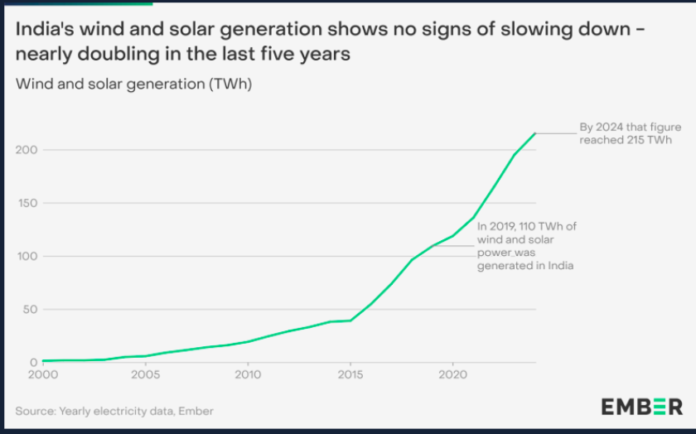India became the world’s third-largest producer of electricity from wind and solar energy in 2024, overtaking Germany.
Wind and solar generated 15 percent of global electricity in 2024; India’s share was 10 percent.
Low-carbon sources, including renewables and nuclear, provided 40.9 percent of global electricity — the highest since the 1940s.
In India, clean sources accounted for 22 percent of electricity generation in 2024; hydropower contributed 8 percent, and wind and solar together 10 percent.
Global renewables added a record 858 TWh of clean electricity in 2024, a 49 percent rise from the previous record in 2022.
Solar added 474 TWh globally in 2024, maintaining its spot as the largest new electricity source for the third year and fastest-growing for the 20th year.
Global solar power generation doubled in three years to 6.9 percent of the electricity mix.
Solar contributed 7 percent of India’s electricity in 2024, doubling since 2021.
India added 24 GW of solar capacity in 2024 — over twice the addition in 2023 — ranking behind only China and the US.
India saw the fourth-largest increase in solar generation globally, adding 20 TWh.
Ember called solar power the “engine of the global energy transition” and emphasized its critical role paired with battery storage.
The Ember report covered 88 countries accounting for 93 percent of global electricity demand, including historical data for 215 countries.
Ember said Asia’s clean energy transition is accelerating, led by solar and other renewables.
A robust clean energy market is essential for energy security, economic resilience, and clean power expansion in emerging countries.
Ember analysts said India has made notable progress in renewables but must accelerate clean generation to meet rising demand.
UN climate chief Simon Stiell called India a “solar superpower” and said embracing clean energy will boost its economic growth.
India’s NDCs aim for 50 percent of installed electric power capacity from non-fossil fuel sources by 2030.
India has also set a goal of achieving 500 GW of non-fossil fuel capacity by 2030.
Ember warned India won’t meet the 500 GW goal without a 20 percent annual funding increase.
GreentechLead.com News Desk

